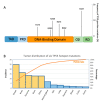Li-Fraumeni Syndrome: Mutation of TP53 Is a Biomarker of Hereditary Predisposition to Tumor: New Insights and Advances in the Treatment
- PMID: 35954327
- PMCID: PMC9367397
- DOI: 10.3390/cancers14153664
Li-Fraumeni Syndrome: Mutation of TP53 Is a Biomarker of Hereditary Predisposition to Tumor: New Insights and Advances in the Treatment
Abstract
Li-Fraumeni syndrome (LFS) is a rare familial tumor predisposition syndrome with autosomal dominant inheritance, involving germline mutations of the TP53 tumor suppressor gene. The most frequent tumors that arise in patients under the age of 45 are osteosarcomas, soft-tissue sarcomas, breast tumors in young women, leukemias/lymphomas, brain tumors, and tumors of the adrenal cortex. To date, no other gene mutations have been associated with LFS. The diagnosis is usually confirmed by genetic testing for the identification of TP53 mutations; therefore, these mutations are considered the biomarkers associated with the tumor spectrum of LFS. Here, we aim to review novel molecular mechanisms involved in the oncogenic functions of mutant p53 in LFS and to discuss recent new diagnostic and therapeutic approaches exploiting TP53 mutations as biomarkers and druggable targets.
Keywords: Li–Fraumeni syndrome (LFS); TP53; biomarker; cancer predisposition; germline mutation.
Conflict of interest statement
The authors declare no conflict of interest.
Figures



References
-
- Schneider K., Zelley K., Nichols K.E., Garber J. Li-Fraumeni Syndrome. National Library of Medicine; Bethesda, MD, USA: 1993.
Publication types
Grants and funding
LinkOut - more resources
Full Text Sources
Research Materials
Miscellaneous

